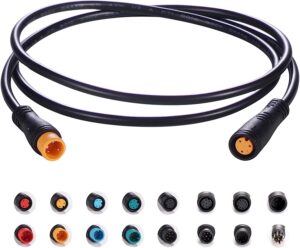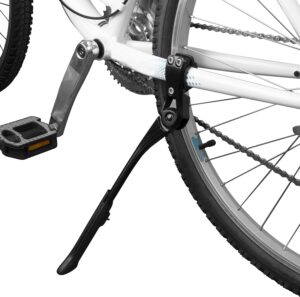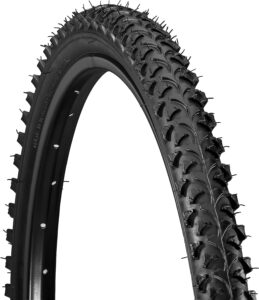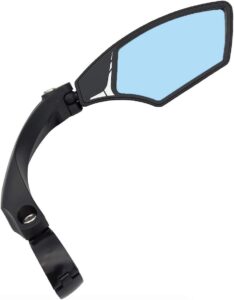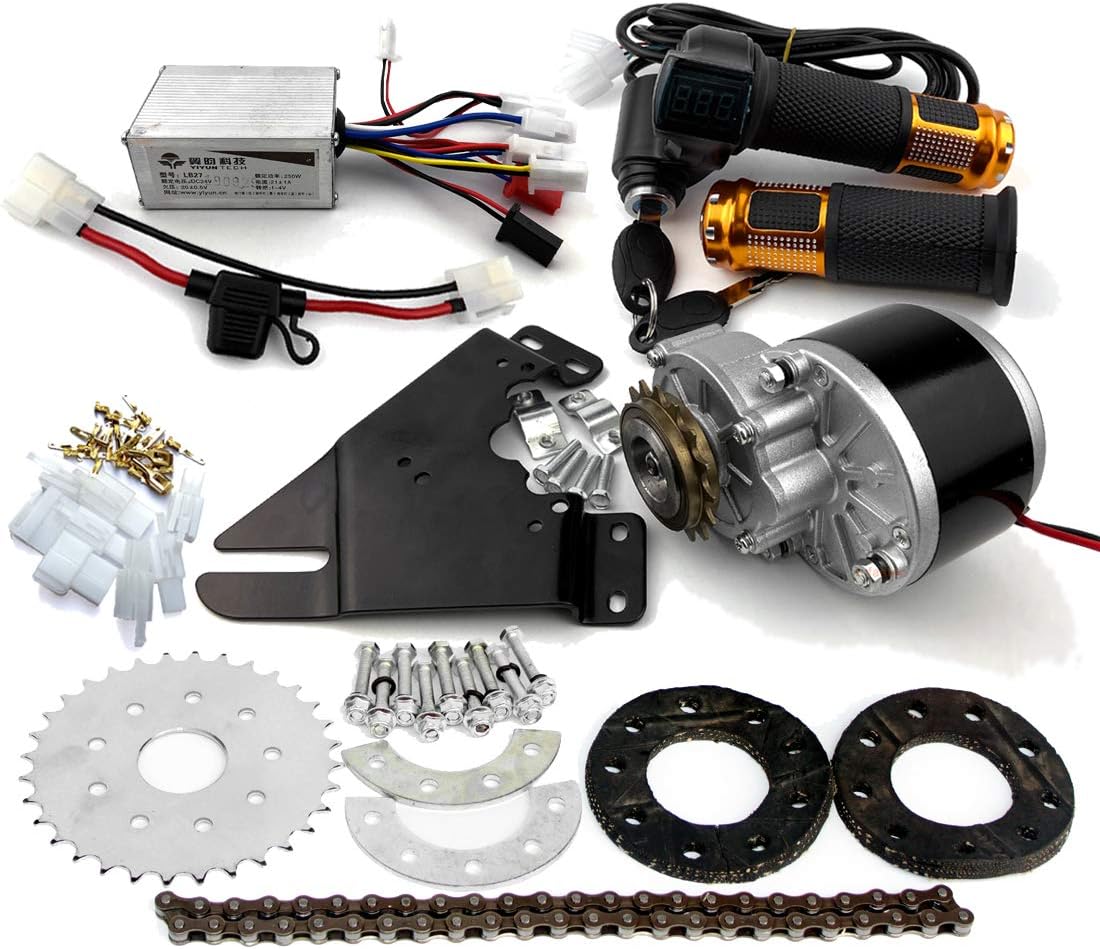
/100
Pros
- Vastly compatible, catering to bicycles employing V brakes at the rear wheel
- Noteworthy for its simplicity in installation. Fear not, a handy install video is your guide!
- Includes an assortment of motor bracket options, extending a charming penchant for versatility
- Controller and motor uphold a reputation for being robust and sturdy. They’re the muscular bodyguards of your e-bike rig, so to speak
- Provides the liberty to choose between twist and thumb throttle types, because, well, variety is always the spice of life, isn’t it?
- Comes in both 24V and 36V options catering to varied riding needs and for those impromptu tour-de-town races you win every time
- Facilitates longer and smoother rides. On account of reading this Electric Conversion Kit Review, your perpetual search for a public transit alternative might just be over!
- Compatible with both the veteran lead acid and the modern, suave lithium batteries
Note: This review is based predominantly on the manufacturer’s descriptions because, let’s face it, this kit isn’t exactly the latest must-have Hollywood gossip. It’s not in every bike shop or on everyone’s lips, so user experiences may be as rare as hens’ teeth. Remember, manufacturers can be understandably biased about their own products. It’s like asking a proud mother to objectively critique her children. Grain of salt, anyone?
Cons
- Not exactly a household name, the Electric Conversion Kit’s somewhat lukewarm sales record suggests it’s still carving out a niche in the market.
- A shortage of unbiased, real-world data due to limited sales and usage can make an impartial ‘Electric Conversion Kit Review’ a bit like spotting a unicorn.
- Remember, manufacturer’s descriptions often rival a Shakespearean sonnet in flattery. So, apply a hefty dose of discernment when reading them.
- Like fitting a square peg into a round hole, the motor bracket may demand some DIY modifications to nestle comfortably into your bike frame.
- Specializing in the V brakes on the rear wheel, this kit might not be the belle of the ball for disc brake or coaster brake systems.
- Think tortoise, not hare. This kit’s motor prioritizes slow and steady rides over high-speed jaunts, making 20 km/h its raison d’être for your 26-inch bike.
- Striving for prolonged rides? It’s advisable to share duties with the motor, a bit like a polite tango between pedaling and powered assistance.
- Although your kit arrives sans battery, it courteously recommends 24V 15Ah or 36V 12Ah capacities in either lead acid or lithium format, adding a separate shopping excursion to your to-do list.
- The motor controller provides 1 fuse wire and 3 fuses. If a fuse burns out, consider it an impromptu whodunit—to prevent a sequel, uncover the culprit’s identity or request for backup from the manufacturer.
- Should the motor mount prove too aloof for your bike frame, prepare to engage your inner MacGyver and come up with a solution.
- The kit’s installation instructions seem to be playing hide and seek, with only a handful of pictures on Amazon and a YouTube video that keeps electrical details cloaked in mystery.
- Aligning the sprockets can be as tricky as a game of Tetris, according to some users, who reported occasional rebellious chains eager to go their own way.
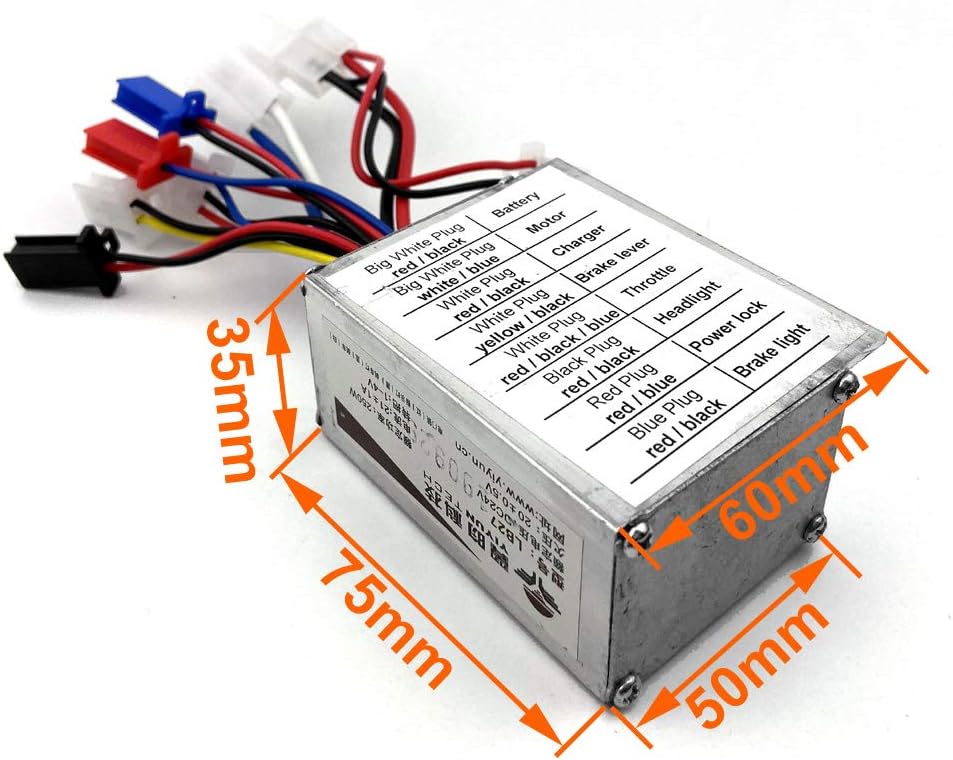
The Electric Conversion Kit Review: An Innovation Earning Its Spots
Beginning our journey through the world of bicycle evolution, we stumble upon the Electric Conversion Kit. This novelty aims to revolutionize the cycling experience by converting conventional bicycles into electric ones, thus paving a new path for the world of eco-friendly commuting and recreational cycling. However, this product still has some inertia to overcome in order to break into mainstream acceptance.
The popularity and sales of the Electric Conversion Kit have yet to reach staggering heights, leaving us with a scarcity of field data for appraisal purposes. As a result, our review leans heavily on the specifications supplied by the manufacturer, an inevitable bias we must bear in mind as we navigate the following insights.
Despite these shortcomings, the Electric Conversion Kit offers a mesmerizing promise: the opportunity to transform a traditional bicycle into an electric powered marvel, unlocking a new dimension of human mobility. What follows is a thorough exploration of this product, with every effort taken to provide an accurate and informative context.
Demystifying Electric Conversion Kits: A Comprehensive Review
Presenting the Electric Conversion Kit, masterfully crafted to align seamlessly with bikes equipped with V-brakes. Regrettably, those with disc brakes and coaster brakes won’t find this kit useful. It’s recommended to pivot towards other available alternatives specifically designed for those types. Want a professional opinion on compatibility? Just snap a picture of your bike and email it to the manufacturer for expert advice.
Not all thorny paths are hopeless; the motor bracket might not be a snug fit for your bike frame at first try. A little facelift may be what’s necessary. The manufacturer encourages DIY modifications. However, if the task seems daunting, reach out to the manufacturer. They’re more than happy to offer guidance.
This kit targets users who prioritize ease over speed. It’s not a speed rocket and tops out at around 20 km/h for a 26-inch bike. To extend your rides, pedal along with the motor power. Do set realistic expectations.
‘Electric Conversion Kit Review’ offers you two flavors: the 24V and 36V. The primary difference is their working current. To maximize your journies, opt for the 36V variant. With extended battery life and higher mileage, it’s a worthy choice.
Note, the battery is on a ‘bring-your-own’ basis. Both lead acid and lithium batteries dance well with this conversion kit. The recommended capacity is 24V 15Ah or 36V 12Ah; select based on your needs.
The kit comes with a maiden voyage-ready controller. If a fuse burns out, no worries, identify the cause, and shield it to prevent future occurrences. Otherwise, customer support is just a call away.
Throttle preferences? The kit got you covered with twist and thumb options. You choose, ‘key throttle’ for twist or ‘thumb throttle’ for the thumb option. Happy pedaling!
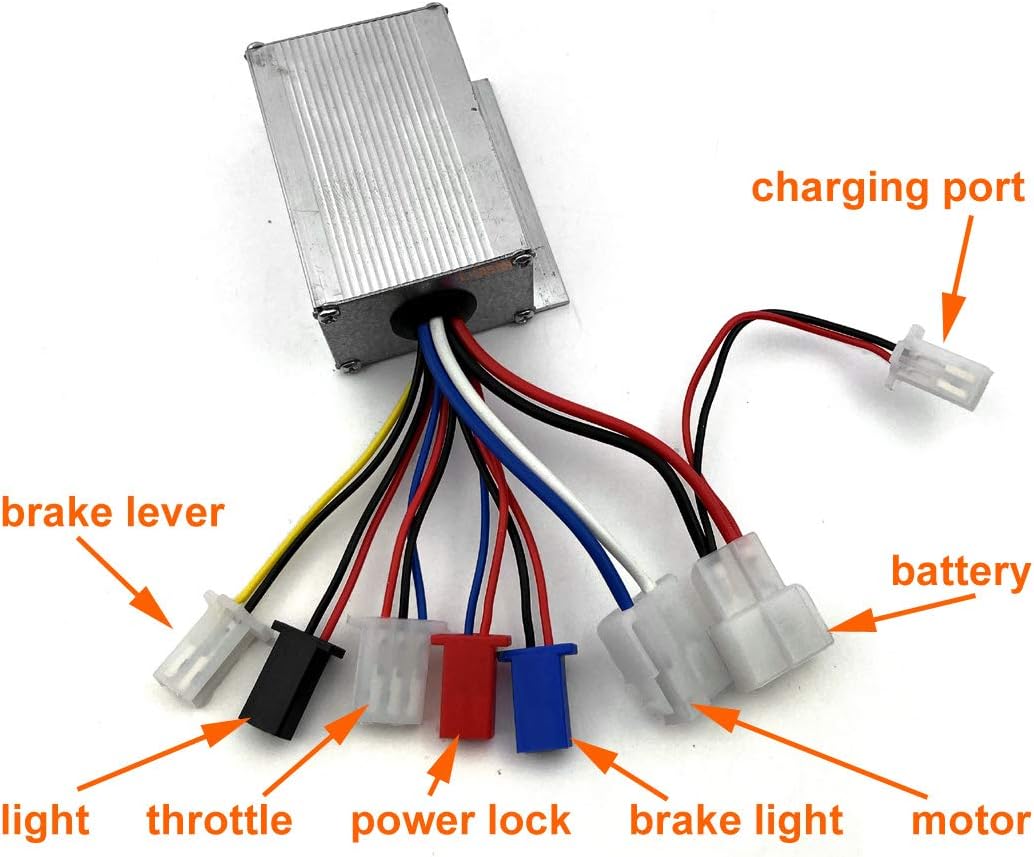
A Dive into Electric Conversion Kit: Reviewing Performance and Speed
Electric Conversion Kit, as described by the manufacturer, appears to have certain limitations in terms of speed and overall performance. With real-life data scarcity and lukewarm sales figures, one might question the validity of the manufacturer’s claims.
Despite these constraints, the purpose of the kit remains clear: to heighten the cycling experience by offering an auxiliary power source, not to turn your bicycle into a speed demon. Capable of hitting a speed of 20km/h on a 26-inch bike, it’s clear the kit wasn’t designed for speedsters, but rather for those who value efficiency and longevity in their rides.
Billed as an effective companion for pedalling, the kit seemingly boosts efficiency, prolonging your ride. Consequently, this product may be best suited for leisurely trips or commutes, and less so for adrenaline-fuelled races.
The kit is available in both 24V and 36V variants, with the primary difference between the two being their respective working currents. Driven by adjustments in current, opting for the 36V kit reportedly enhances battery life, thus making it the ideal choice for longer journeys according to the manufacturers.
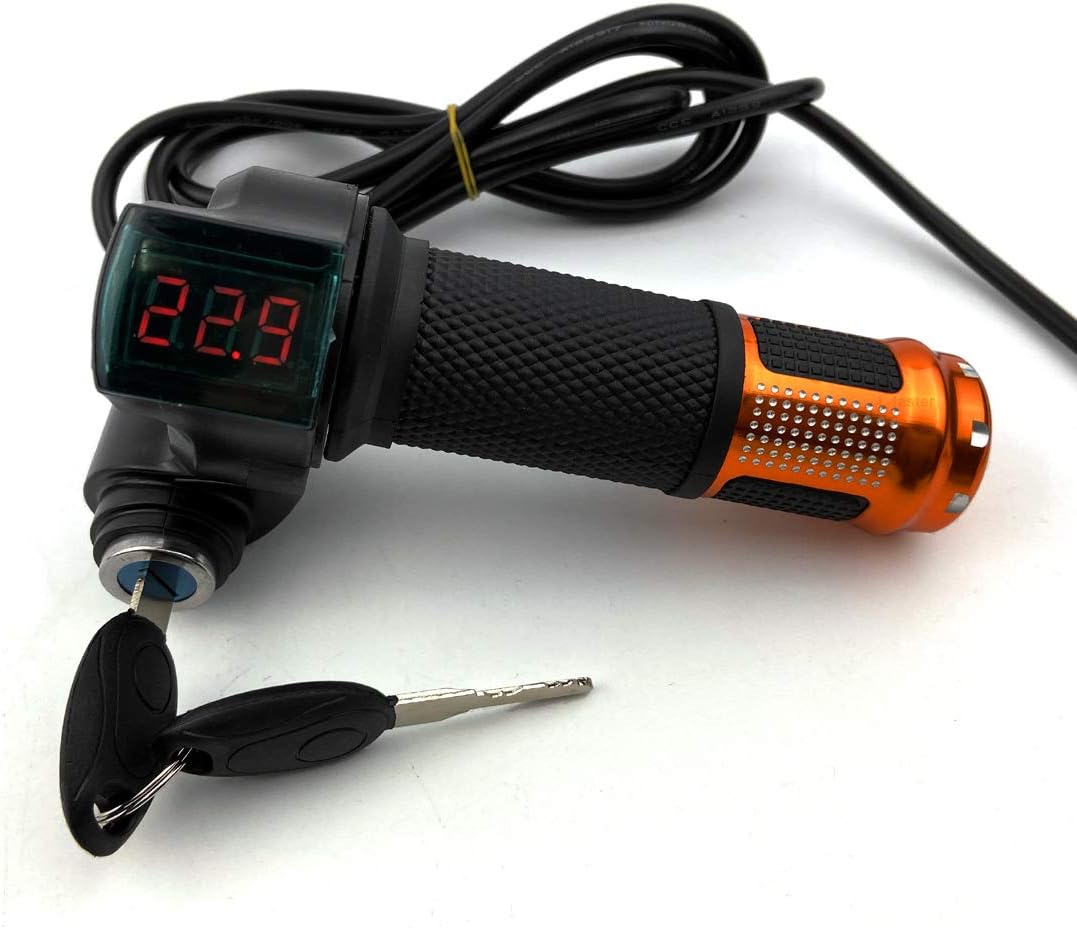
Electrifying Enhancements: A Comprehensive Electric Conversion Kit Review
Dive into the extensive array of supplementary components and additional features offered by the Electric Conversion Kit, designed to take your biking experience up a notch. However, a subtle impasse presents itself upfront: the lack of a battery included with this kit. Purchasing it separately will be required, and for an ideal blend of durability and potency, both lead acid and lithium batteries are good suitors. A 24V 15Ah or 36V 12Ah capacity is typically recommended for this high-flyer.
You’re not simply buying a conversion kit, you’re investing in a bevvy of supplementary features. Encased within are a controller, 1 fuse wire, and 3 spare fuses to keep any electrical mishaps at bay. As the saying goes, ‘a burnt fuse never strikes twice’; it’s vital to identify the root cause if a fuse should fail, and eliminate any chance of recurrence. You aren’t left adrift here: customer support is merely a call away.
Personalize your riding experience with two distinct throttle types for controlling the motor: a twist throttle or a thumb throttle. Choose what feels natural and comfortable for your ride. But keep in mind, this kit plays nice with bikes featuring V-brakes on the rear wheel. Disc or coaster brakes bikers, take heed; compatibility might be an issue. The motor bracket may demand a little tweak or two to fit your bike’s frame. When in doubt, snap a photo of your steed and reach out for expert advice.
Now, if speed thrills are your thing, this kit might leave you wanting more. It’s made for convenience over velocity. Fitted on a 26-inch bike, expect to cruise with this kit at roughly 20km/h. For an extended, enjoyable ride, get pedaling and let the motor assist. It’s a duo made in cycling heaven.
A valid point to ponder: the data on this kit’s performance and popularity can leave much to the imagination due to relatively low sales figures. Introduction, meet grain of salt. The review primarily leans on the manufacturer’s own, perhaps slightly rosy, descriptions. Food for thought, indeed.
Conclusion
In light of the vast array of compatibility, versatility, and robustness, the Electric Conversion Kit presents itself as a noteworthy option for those seeking a cost-effective alternative to public transport or the classic bicycle. Its commendable performance under diverse conditions, courtesy of its reliable motor and controller, along with handy features such as a choice between throttle types and compatibility with popular battery types, fortify its appeal. The presence of a user-friendly installation guide further rounds off its positives.
However, with limited real-world data available and its current standing as an underdog in the market, exercising discernment while evaluating its features is crucial. The requirement of DIY adaptations for the motor bracket and certain limitations such as compatibility with specific brake types can pose challenges. Mention must also be made of the exclusion of batteries from the kit and potential hiccups in the installation process. Balancing these pros and cons, the Electric Conversion Kit represents a promising prospect for those ready to take on a bit of a DIY challenge and slow-paced cycling adventures, while still offering the discretion to approach it with a healthy dose of skepticism.
Similar E-Bikes to the Electric Conversion Kit
Derek Hayes, a vivacious transportation trailblazer, seamlessly merging passion with sustainability. Immersed in the world of ebikes, bicycles, and escooters, Derek champions alternative modes of transport. His enthusiasm spills over into daily life, inspiring others to adopt these eco-friendly commuting options. With an unrivaled knowledge of the latest electrified gadgets, he is both a guide and a mentor. Around town, you'll spot Derek effortlessly gliding on the newest scooter or testing a high-tech ebike. His boundless energy and commitment to sustainable living make him much more than just an enthusiast – he is an ambassador for a green and alternative future.

